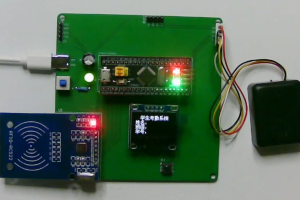设计说明书
总字数:11000+
摘 要
各类智慧教育产品广泛应用于教育教学、教育科研和教育管理等方面,促进了现代教育的发展。学生考勤作为教育管理的一个子模块,同时也是校风建设中的一项重要工作。建立完善的考勤制度,对于促进学生上学积极性,保证教学秩序,提高人才培养质量具有重要的作用教师点名、校领导视察等传统的考勤方式不仅效率低下,而且耗费了大量的时间和人力成本,呱需现代信息技术对其进行变革。为了有效保障教学秩序,设计一款学生考勤监测系统,本设计通过RFID刷卡显示学生信息姓名、班级和学号,通过OLED显示屏显示数据,通过按键确认签到,并语音播报谁未到,以上模块共同配合,共同完成学生考勤监测。通过实物测试,该学生考勤系统能够明显提高考勤效率,后台业务处理功能完备,消息推送实时性强。
关键词:考勤;显示屏;单片机;测控;语音播报
Abstract
Various types of smart education products are widely used in education and teaching, educational research, and educational management, promoting the development of modern education. Student attendance, as a sub module of education management, is also an important task in the construction of school culture. Establishing a sound attendance system plays an important role in promoting students’ enthusiasm for attending school, ensuring teaching order, and improving the quality of talent cultivation. Traditional attendance methods such as teacher roll calling and school leadership inspections are not only inefficient, but also consume a lot of time and labor costs. Modern information technology is needed to transform them.In order to effectively ensure teaching order, a student attendance monitoring system is designed. This design displays student information, name, class, and student ID through RFID card swiping, displays data through OLED display screen, confirms check-in through buttons, and broadcasts who has not arrived through voice. The above modules work together to complete student attendance monitoring.Through physical testing, the student attendance system can significantly improve attendance efficiency, with complete backend business processing functions and strong real-time message push.
Key words: attendance; Display screen; Single chip microcomputer; Measurement and control; Voice Announcements
目 录
第1章 绪 论
1.1 发展背景和现实意义
1.2国内外发展现状
1.3 设计功能实现
第2章 系统设计分析
2.1 系统总体设计分析
2.2 元器件选择
2.2.1 单片机的选择
2.2.2 按键的选择
2.2.3显示模块方案选择
第3章 控制系统硬件设计
3.1 单片机最小系统
3.1.1 主控模块电路
3.1.2 晶振电路
3.1.3 复位电路
3.1.4 电源电路
3.1.5 下载电路
3.2 RFID刷卡模块
3.3独立按键模块电路
3.4语音播报模块(TTS)
3.5 显示模块电路
第4章 系统程序设计
4.1 编程软件介绍
4.2 系统主流程设计
4.3 独立按键
4.4 OLED显示流程设计
第5章 实物测试
5.1 实物焊接
5.2 实物总体设计
5.3实物功能测试
总 结
参考文献
附 录
附录1:原理图
附录2:PCB
附录3:主程序
购买后可查看具体内容!

